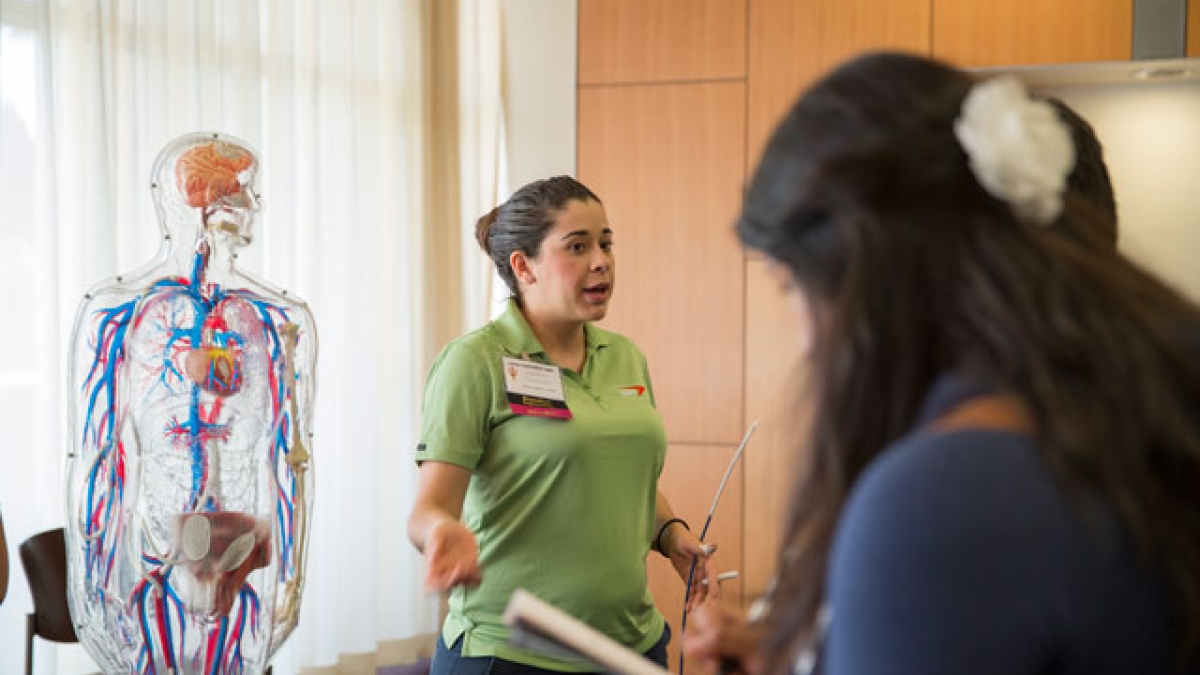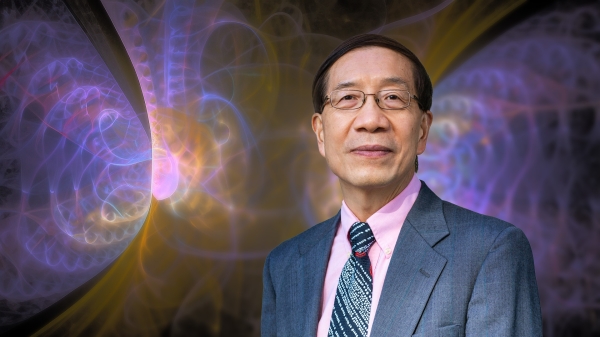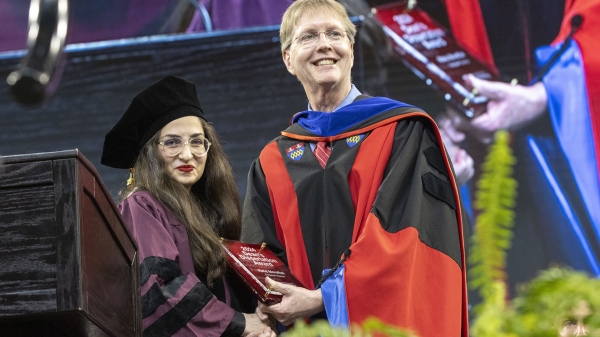High-tech company W. L. Gore invested in ASU engineering students’ success

Carolina Tostado, a biomedical engineering alumna and engineer at W. L. Gore & Associates, supports students and recruitment efforts by representing Gore at the Ira A. Fulton Schools’ Career Exploration Night for Freshmen. Photo by Jessica Hochreiter/ASU
A great partnership is one that helps both parties to excel in their goals. The Ira A. Fulton Schools of Engineering and W. L. Gore & Associates have one specific goal in mind — to educate and employ world-class engineers who will move Arizona’s economy forward.
This partnership began more than a decade ago with a gift from Gore to the Fulton Schools of Engineering and remains vibrant today.
Gore is a technology and science-based enterprise that has a reputation for creating innovative, technology-driven solutions. Health-care professionals and biomedical engineers respect their contributions in medical devices and implants, while outdoor enthusiasts and material scientists esteem them for producing high-performance Gore-Tex fabrics.
Co-developing a future workforce
Gore’s interest in supporting Fulton Schools’ students stems from its dependence on a highly skilled workforce in Arizona.
“Arizona is our home, and for us to stay and thrive we require world-class workers to come out of universities like ASU,” said Mike Vonesh, who offers leadership for the technical team in the Medical Products Division.
The company was founded in Delaware in 1958, and Flagstaff, Arizona, became the hub of Gore’s medical product division in the early 1970s. They recently expanded into northern Phoenix with new manufacturing facilities — making collaborations with ASU even more accessible.
Gore has an open dialogue with Fulton Schools about traits and experiences that the ideal engineering graduate should possess.
“We consider the Fulton Schools our partners. They hear our voice about what skills sets we’re looking for in graduating students and are willing to structure curriculum based on the industry’s needs,” said Vonesh, adding that ASU is uniquely receptive in this regard, which makes its graduates very desirable.
Vonesh serves as an industry representative on the board for the School of Biological and Health Systems Engineering, one of the six Ira A. Fulton Schools of Engineering.
“He offers the industry perspective in terms of the skill set that industries need from engineers and therefore what we should be implementing in our curriculum,” said Marco Santello, a biomedical engineering professor and the school’s director.
Gore also collaborates with the University of Arizona and Northern Arizona University.
By investing in Arizona’s universities Gore is creating a strong workforce that helps their company to succeed and returns a dividend to the Arizona economy.
“We don’t look at these gifts as philanthropy, but rather as a trusted investment,” said Vonesh.
Supporting student success programs
Students in the Fulton Schools benefit from Gore’s collaboration through industry involvement in engineering research projects, and support for undergraduate scholarships, student organizations and programs that enhance the student experience.
Gore champions and supports the Fulton Schools Accelerated 4+1 program, which allows students to earn a bachelor’s and master’s degree in engineering in five years.
They also judge design reviews for the Engineering Projects in Community Service (EPICS) Program. At these reviews students present their team’s project before an industry panel for technical feedback, allowing them to further improve the design and implementation of their engineering solutions.
“Gore supports many engineering programs that impact a number of our students,” said Margo Burdick, associate director of development in the Fulton Schools.
“Besides their philanthropic support they are very supportive with their time by attending many Fulton Schools’ events throughout the year,” added Burdick.
Gore has been particularly involved in supporting biomedical, chemical, mechanical, manufacturing electrical and materials science engineering programs, which are disciplines related to Gore’s technological focuses.
Many of Gore’s innovations stem from the use of proprietary technology with the versatile polymer polytetrafluoroethylene, which is used in fabrics, products for electronic signal transmission, medical implants, as well as filtration, sealant and fibers technologies for diverse industries.
Gore has been granted more than 2,000 patents worldwide and more than 40 million Gore Medical Devices have been implanted, saving and improving the quality of millions of lives around the world.
Alumni stay involved through partnership
Dozens of Fulton Schools’ students have gone on to work for Gore since the collaboration began. A handful of these students remain closely tied to ASU through recruitment and outreach efforts.
Biomedical engineering alumna Carolina Tostado, who graduated in 2012, supports new product development as a quality engineer and is also one of Gore’s College Champions for ASU. In this role, she serves as a recruiting liaison between college recruiting and technical associates at Gore and ASU.
“I focus on identifying areas where Gore can partner with the Fulton Schools to enhance the student experience such as funding and support for EPICS projects, undergraduate scholarships and particular research programs,” said Tostado.
Tostado regularly attends a variety of events at ASU including the biannual Fulton Schools of Engineering Career Fairs and Career Exploration Night for Freshmen, on-campus interview events, student organizations’ meetings, EPICS design reviews and industry panels.
She is joined by additional alumni and current Gore employees Annette Dunn, bachelor’s degree in mechanical engineering in 2011, Lindsey Jossund, bachelor’s degree in chemical engineering in 2005, and Daniel Dominguez, bachelor’s degree in mechanical engineering in 2015.
“In addition to recruiting efforts, we work to identify ways that Gore can connect with students and faculty. Our goal is to build relationships and participate in activities that benefit all three parties: engineering students, ASU and Gore,” said Jossund who works as a technical leader for one of Gore’s medical products.
“I am always energized by the innovative work from students on campus,” said Dunn who interned with Gore after her junior year. After two internships at Gore and some time in manufacturing engineering support, she currently works as an engineer in new product development.
“I think it’s important to build strong connections between industry and the university to continue to be inspired and help grow top talent,” added Dunn.
Dominguez began working for Gore in 2015 as a process engineer, but his familiarity with the company and their partnership with the Fulton Schools began as a student.
“I interacted with Gore as a student through information sessions, recruiting events, an internship and scholarship support,” said Dominguez.
He enjoys making campus visits on behalf of Gore because it is a way for him to help students that remind him of his student-self with professional mentorship and funding.
“Interactions like these are important to me because this is how I paid for school, participated in extracurricular activities and stayed focused on academics,” he said.
Tostado shares this commitment: “As someone who relied on mentors during college to shape my engineering career, I hope that I can provide some guidance and share opportunities with students that can help them be successful. This makes me feel like I am paying back to my community.”
More Science and technology
Extreme HGTV: Students to learn how to design habitats for living, working in space
Architecture students at Arizona State University already learn how to design spaces for many kinds of environments, and now they…

Human brains teach AI new skills
Artificial intelligence, or AI, is rapidly advancing, but it hasn’t yet outpaced human intelligence. Our brains’ capacity for…

Doctoral students cruise into roles as computer engineering innovators
Raha Moraffah is grateful for her experiences as a doctoral student in the School of Computing and Augmented Intelligence, part…